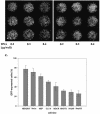Surfection: a new platform for transfected cell arrays
- PMID: 14973329
- PMCID: PMC373424
- DOI: 10.1093/nar/gnh029
Surfection: a new platform for transfected cell arrays
Abstract
Efficient high-throughput expression of genes in mammalian cells can facilitate large-scale functional genomic studies. Towards this aim, we developed a simple yet powerful method to deliver genes into cells by cationic polymers on the surface of substrates. Transfection can be achieved by directly contacting nucleic acid-cell mixtures with the cationic substrates, e.g. polyethylenimine/collagen-coated wells. This single-step matrix-surface- mediated transfection method, termed 'surfection', can efficiently deliver multiple plasmids into cells and can successfully assay siRNA-mediated gene silencing. This technology represents the easiest method to transfer combinations of genes in large-scale arrays, and is a versatile tool for live-cell imaging and cell-based drug screening.
Figures






Similar articles
-
A simplified polyethylenimine-mediated transfection process for large-scale and high-throughput applications.Methods. 2011 Sep;55(1):44-51. doi: 10.1016/j.ymeth.2011.04.002. Epub 2011 Apr 24. Methods. 2011. PMID: 21539918
-
Serum as a modulator of lipoplex-mediated gene transfection: dependence of amphiphile, cell type and complex stability.J Gene Med. 2000 Nov-Dec;2(6):465-76. doi: 10.1002/1521-2254(200011/12)2:6<465::AID-JGM141>3.0.CO;2-Z. J Gene Med. 2000. PMID: 11199267
-
RNAi microarray analysis in cultured mammalian cells.Genome Res. 2003 Oct;13(10):2341-7. doi: 10.1101/gr.1478703. Genome Res. 2003. PMID: 14525932 Free PMC article.
-
Usefulness of the luciferase reporter system to test the efficacy of siRNA.Methods Mol Biol. 2006;342:181-7. doi: 10.1385/1-59745-123-1:181. Methods Mol Biol. 2006. PMID: 16957375 Review.
-
High throughput screening of gene functions in mammalian cells using reversely transfected cell arrays: review and protocol.Comb Chem High Throughput Screen. 2008 Feb;11(2):159-72. doi: 10.2174/138620708783744499. Comb Chem High Throughput Screen. 2008. PMID: 18336209 Review.
Cited by
-
Kinase shRNA screening reveals that TAOK3 enhances microtubule-targeted drug resistance of breast cancer cells via the NF-κB signaling pathway.Cell Commun Signal. 2020 Oct 21;18(1):164. doi: 10.1186/s12964-020-00600-2. Cell Commun Signal. 2020. PMID: 33087151 Free PMC article.
-
Substrate-mediated delivery from self-assembled monolayers: effect of surface ionization, hydrophilicity, and patterning.Acta Biomater. 2005 Sep;1(5):511-22. doi: 10.1016/j.actbio.2005.05.004. Epub 2005 Jul 25. Acta Biomater. 2005. PMID: 16701831 Free PMC article.
-
Efficacy of immobilized polyplexes and lipoplexes for substrate-mediated gene delivery.Biotechnol Bioeng. 2009 Apr 15;102(6):1679-91. doi: 10.1002/bit.22212. Biotechnol Bioeng. 2009. PMID: 19148921 Free PMC article.
-
Site-specific gene transfer with high efficiency onto a carbon nanotube-loaded electrode.J R Soc Interface. 2008 Aug 6;5(25):909-18. doi: 10.1098/rsif.2007.1295. J R Soc Interface. 2008. PMID: 18192165 Free PMC article.
-
Spatially and temporally controlled gene transfer by electroporation into adherent cells on plasmid DNA-loaded electrodes.Nucleic Acids Res. 2004 Dec 21;32(22):e187. doi: 10.1093/nar/gnh176. Nucleic Acids Res. 2004. PMID: 15613595 Free PMC article.
References
-
- Shea L.D., Smiley,E., Bonadio,J. and Mooney,D.J. (1999) DNA delivery from polymer matrices for tissue engineering. Nat. Biotechnol., 17, 551–554. - PubMed
-
- Klugherz B.D., Jones,P.L., Cui,X., Chen,W., Meneveau,N.F., DeFelice,S., Connolly,J., Wilensky,R.L. and Levy,R.J. (2000) Gene delivery from a DNA controlled-release stent in porcine coronary arteries. Nat. Biotechnol., 18, 1181–1184. - PubMed
-
- Honma K., Ochiya,T., Nagahara,S., Sano,A., Yamamoto,H., Hirai,K., Aso,Y. and Terada,M. (2001) Atelocollagen-based gene transfer in cells allows high-throughput screening of gene functions. Biochem. Biophys. Res. Commun., 289, 1075–1081. - PubMed
-
- Perlstein I., Connolly,J.M., Cui,X., Song,C., Li,Q., Jones,P.L., Lu,Z., DeFelice,S., Klugherz,B., Wilensky,R. et al. (2003) DNA delivery from an intravascular stent with a denatured collagen-polylactic-polyglycolic acid-controlled release coating: mechanisms of enhanced transfection. Gene Ther., 10, 1420–1428. - PubMed
-
- Jang J.H. and Shea,L.D. (2003) Controllable delivery of non-viral DNA from porous scaffolds. J. Control. Release, 86, 157–168. - PubMed
MeSH terms
Substances
LinkOut - more resources
Full Text Sources
Other Literature Sources

